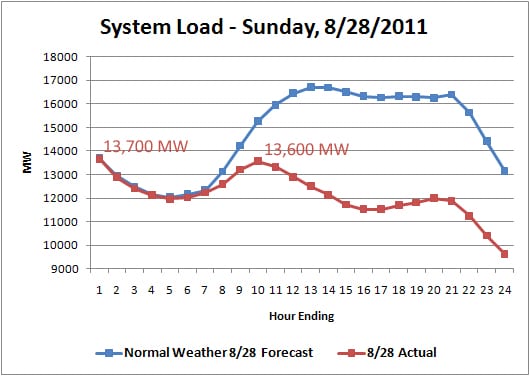Hurricane Irene and the New England power grid
 Credit: National Oceanic and Atmospheric Administration
Credit: National Oceanic and Atmospheric Administration
Hurricane Irene will go down in the history books in New England. Massive flooding washed out roads and swept away bridges. High winds toppled trees, damaged homes, and took down power lines. In the immediate aftermath of the storm, as many as 2.1 million New England customers were estimated to be without power.
While Irene was bearing down on the Northeast, ISO New England and the Local Control Centers in the region, working with the owners of the region’s power system infrastructure, including transmission owners, utilities, generators and others, mobilized additional resources and implemented emergency plans days in advance of the extreme weather. ISO New England and these entities were in close communication before, during, and after the storm to ensure a tightly coordinated approach to operation of the region’s power system.
Before the storm, ISO New England stationed personnel at its backup control center and brought in additional control room operators and engineering, market operations, facilities, and information technology personnel to the main control center. While New England system operators were preparing to operate the region’s grid through hurricane conditions, so too were our neighboring control area operators in New York, Quebec, Ontario, and New Brunswick. The close communication among the ISOs and among New England industry entities helped ensure that all were coordinated and available to help each other, if needed.
On Friday at noon, ISO New England implemented its abnormal condition alert procedure, Master/Local Control Center Procedure 2, and issued a special alert. M/LCC-2 was declared as a precautionary measure to cancel or postpone scheduled generation and transmission outages to ensure that the power system was in the highest state of readiness. The declaration continued throughout the restoration process.
ISO New England and the Local Control Center operators maintained reliable operations on the region’s high-voltage power system, despite the fact that the storm caused outages to approximately 40 high-voltage transmission lines and some generation units. The storm also caused significant damage to the region’s distribution system infrastructure; the dramatic decline in customer demand mitigated the effects of the transmission and generation outages. Unlike managing the flow of power on the system when demand is peaking, ISO control room operators had to ensure that not too much power was being produced at any time, while keeping enough generating units on line in case they were needed if others tripped off, or as load was reconnected.
On Sunday morning, demand rose to about 13,600 megawatts (MW) at 10 a.m., and then dropped to below 9,000 MW at its lowest point early Monday morning.
This graph shows a comparison of what forecasted demand would have looked like absent the storm and actual demand on the power system on Sunday, August 28. The graph also shows that the actual “peak” for Sunday was within the first hour of the day, at approximately 13,700 MW, and that demand never recovered to that level in that 24-hour period.

ISO New England will continue to work closely with transmission and generation owners and the Local Control Centers as they continue to restore power across the region.
- Categories
- Inside ISO New England
- Tags
- forecast, system operations
